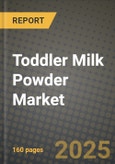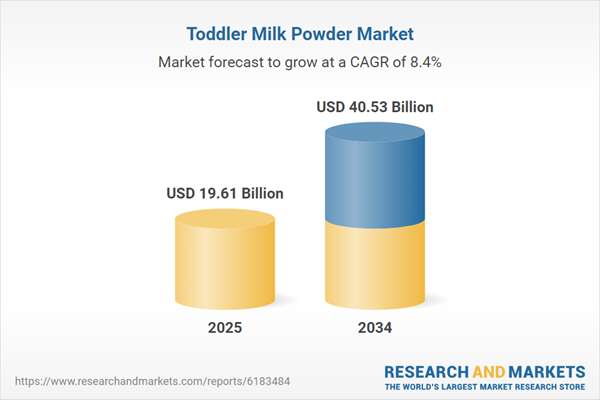Toddler Milk Powder Market
The toddler milk powder market targets children roughly 1-3 years (and in some cases up to 6 years), positioned as a bridge between infant formula and diversified family diets. Products are offered in cow-, goat-, and specialty bases, often fortified with DHA/ARA, HMOs or pre/pro/synbiotics, nucleotides, iron, calcium, and vitamins A-D to support growth, bone health, immunity, and cognitive/visual development. Growth is powered by urbanization, higher dual-income households, rising nutrition awareness, and the need for convenient, shelf-stable options where toddlers have picky eating patterns, limited food diversity, or increased infection risk from daycare/school exposure. Premiumization is evident in lactose-dominant, reduced-sucrose, organic, grass-fed, A2/protein-specific, and allergen-managed formulations, as well as in packaging (re-closeable cans, smart lids, scoop organizers, single-serve sachets) that signal safety and hygiene. Competition blends global pediatric nutrition majors, strong regional dairy players, pharmacy/clinic-recommended brands, and cross-border e-commerce lines favored in Asia. Regulatory scrutiny remains high around composition, labeling, and marketing to young children, while professional bodies continue to clarify that toddler milks should not replace a balanced diet - pushing brands to frame products as “nutritional support” or “for fussy eaters.” Key challenges include commodity-price volatility (dairy fats, whey), supply-chain integrity, growing skepticism about added sugars/flavors, and tighter claims control. As parents seek safer, traceable, and immune-supportive nutrition, winning portfolios are those that combine science-backed fortification, clean label/no undesirable additives, transparent sourcing, and communication aligned with pediatric guidance.Toddler Milk Powder Market Key Insights
- Positioning shift: complement, not replace. Leading brands emphasize “fills nutrient gaps,” “fussy/picky eater support,” and “immunity & growth” instead of implying equivalence to breastmilk or full meal replacement.
- Digestive comfort is a purchase driver. Gentle proteins (partially hydrolyzed or A2), balanced whey:casein ratios, GOS/FOS or HMO-type prebiotics, and low-osmolality recipes reduce spit-up, constipation, and parent call-backs.
- Sugar and flavor scrutiny. Parents and regulators are watching sucrose, glucose syrups, and flavorings; maltodextrin-free or low-sugar SKUs, plus vanilla-free variants, gain trust with health-conscious buyers.
- Immunity and microbiome story. Synbiotic blends, added vitamin D/C, zinc, and nucleotides support “everyday defense” marketing - especially relevant for daycare-going toddlers exposed to infections.
- Dairy differentiation. Organic, grass-fed, NZ/EU-origin milk, goat-based, and A2 protein lines let brands premiumize and reassure on farming practices, traceability, and tolerability.
- Allergy and intolerance niches. Lactose-reduced, soy-based, or hydrolyzed-protein toddler milks address atopic or dairy-sensitive children, often sold via healthcare/pharmacy channels.
- Format and hygiene matter. Easy-scoop lids, tamper-evident closures, foil/seal protection, and smaller trial cans suit on-the-go and e-commerce buyers; sachets work for travel and childcare centers.
- Clinical proof and KOL support. Instrumented growth, iron/vitamin D status, or immunity endpoints - plus endorsements from pediatric dietitians - help justify premium pricing and counter “unnecessary product” narratives.
- Local fortification rules shape recipes. Iron, vitamin D, iodine, and DHA levels vary by region; multi-country brands need adaptable premix strategies and packaging that communicates to parents clearly.
- Sustainability and transparency. Responsible dairy sourcing, recyclable cans, and QR-based trace-back strengthen brand trust, especially after any safety recalls in the category.
Toddler Milk Powder Market Reginal Analysis
North America
Parents use toddler milks as nutritional insurance for selective eaters and for day-care routines. Clean-label, organic, grass-fed, A2, and low/zero-added-sugar claims are strong pull factors. Retail is omnichannel - club, mass, pharmacy, and D2C subscriptions. Regulators’ and pediatric bodies’ cautious messaging pushes brands toward “supplemental” rather than “essential” positioning.Europe
Strict compositional and marketing controls, plus a strong food-culture emphasis on family meals, make “gap-filling” and “immune support” the most acceptable claims. Premium dairy origin, organic certification, and reduced-sugar/lactose-balanced formulas resonate. Pharmacies and para-pharmacies are important recommendation channels; sustainability (recyclable tins, certified farms) is increasingly in tenders.Asia-Pacific
This is the demand center, driven by urban two-income families, premiumization, and cross-border e-commerce. Chinese, Korean, and Southeast Asian parents favor imported/formula-line extensions with HMOs, DHA/ARA, immune and cognitive claims. Goat milk, A2, and traceable-origin SKUs are gaining; anti-counterfeit packaging and QR-based authenticity checks are critical.Middle East & Africa
High reliance on packaged nutrition for toddlers in urban and expat communities. Heat-stable, long-shelf-life cans and halal-certified ingredients are must-haves. Immunity, iron, and vitamin D fortification address regional deficiencies. Modern trade and pharmacies dominate, with growing e-commerce for premium imports.South & Central America
Toddler milks support households facing dietary gaps and irregular access to fresh dairy. Affordability is key, so local dairy players compete with more basic fortified powders, while multinationals push premium SKUs via pharmacies and online. Lactose-reduced, iron-rich, and vitamin A/D-fortified products address regional health priorities.Toddler Milk Powder Market Segmentation
By Age Group
- 0 to 12 months
- 12 to 24 months
- 24 to 36 months
By Application
- Online
- Offline
Key Market players
Nestlé S.A., Danone S.A., Abbott Laboratories, FrieslandCampina N.V., Reckitt Benckiser Group plc (Mead Johnson), Fonterra Co-operative Group Ltd., Arla Foods amba, Yili Group, China Mengniu Dairy Co. Ltd., Feihe International Inc., Ausnutria Dairy Corp. Ltd., Yashili International Holdings Ltd., Bellamy’s Organic, H&H Group (Biostime), Morinaga Milk Industry Co. Ltd.Toddler Milk Powder Market Analytics
The report employs rigorous tools, including Porter’s Five Forces, value chain mapping, and scenario-based modelling, to assess supply-demand dynamics. Cross-sector influences from parent, derived, and substitute markets are evaluated to identify risks and opportunities. Trade and pricing analytics provide an up-to-date view of international flows, including leading exporters, importers, and regional price trends.Macroeconomic indicators, policy frameworks such as carbon pricing and energy security strategies, and evolving consumer behaviour are considered in forecasting scenarios. Recent deal flows, partnerships, and technology innovations are incorporated to assess their impact on future market performance.
Toddler Milk Powder Market Competitive Intelligence
The competitive landscape is mapped through proprietary frameworks, profiling leading companies with details on business models, product portfolios, financial performance, and strategic initiatives. Key developments such as mergers & acquisitions, technology collaborations, investment inflows, and regional expansions are analyzed for their competitive impact. The report also identifies emerging players and innovative startups contributing to market disruption.Regional insights highlight the most promising investment destinations, regulatory landscapes, and evolving partnerships across energy and industrial corridors.
Countries Covered
- North America - Toddler Milk Powder market data and outlook to 2034
- United States
- Canada
- Mexico
- Europe - Toddler Milk Powder market data and outlook to 2034
- Germany
- United Kingdom
- France
- Italy
- Spain
- BeNeLux
- Russia
- Sweden
- Asia-Pacific - Toddler Milk Powder market data and outlook to 2034
- China
- Japan
- India
- South Korea
- Australia
- Indonesia
- Malaysia
- Vietnam
- Middle East and Africa - Toddler Milk Powder market data and outlook to 2034
- Saudi Arabia
- South Africa
- Iran
- UAE
- Egypt
- South and Central America - Toddler Milk Powder market data and outlook to 2034
- Brazil
- Argentina
- Chile
- Peru
Research Methodology
This study combines primary inputs from industry experts across the Toddler Milk Powder value chain with secondary data from associations, government publications, trade databases, and company disclosures. Proprietary modeling techniques, including data triangulation, statistical correlation, and scenario planning, are applied to deliver reliable market sizing and forecasting.Key Questions Addressed
- What is the current and forecast market size of the Toddler Milk Powder industry at global, regional, and country levels?
- Which types, applications, and technologies present the highest growth potential?
- How are supply chains adapting to geopolitical and economic shocks?
- What role do policy frameworks, trade flows, and sustainability targets play in shaping demand?
- Who are the leading players, and how are their strategies evolving in the face of global uncertainty?
- Which regional “hotspots” and customer segments will outpace the market, and what go-to-market and partnership models best support entry and expansion?
- Where are the most investable opportunities - across technology roadmaps, sustainability-linked innovation, and M&A - and what is the best segment to invest over the next 3-5 years?
Your Key Takeaways from the Toddler Milk Powder Market Report
- Global Toddler Milk Powder market size and growth projections (CAGR), 2024-2034
- Impact of Russia-Ukraine, Israel-Palestine, and Hamas conflicts on Toddler Milk Powder trade, costs, and supply chains
- Toddler Milk Powder market size, share, and outlook across 5 regions and 27 countries, 2023-2034
- Toddler Milk Powder market size, CAGR, and market share of key products, applications, and end-user verticals, 2023-2034
- Short- and long-term Toddler Milk Powder market trends, drivers, restraints, and opportunities
- Porter’s Five Forces analysis, technological developments, and Toddler Milk Powder supply chain analysis
- Toddler Milk Powder trade analysis, Toddler Milk Powder market price analysis, and Toddler Milk Powder supply/demand dynamics
- Profiles of 5 leading companies - overview, key strategies, financials, and products
- Latest Toddler Milk Powder market news and developments
Additional Support
With the purchase of this report, you will receive:- An updated PDF report and an MS Excel data workbook containing all market tables and figures for easy analysis.
- 7-day post-sale analyst support for clarifications and in-scope supplementary data, ensuring the deliverable aligns precisely with your requirements.
- Complimentary report update to incorporate the latest available data and the impact of recent market developments.
This product will be delivered within 1-3 business days.
Table of Contents
Companies Mentioned
- Nestlé S.A.
- Danone S.A.
- Abbott Laboratories
- FrieslandCampina N.V.
- Reckitt Benckiser Group PLC (Mead Johnson)
- Fonterra Co-operative Group Ltd.
- Arla Foods amba
- Yili Group
- China Mengniu Dairy Co. Ltd.
- Feihe International Inc.
- Ausnutria Dairy Corp. Ltd.
- Yashili International Holdings Ltd.
- Bellamy’s Organic
- H&H Group (Biostime)
- Morinaga Milk Industry Co. Ltd.
Table Information
| Report Attribute | Details |
|---|---|
| No. of Pages | 160 |
| Published | November 2025 |
| Forecast Period | 2025 - 2034 |
| Estimated Market Value ( USD | $ 19.61 Billion |
| Forecasted Market Value ( USD | $ 40.53 Billion |
| Compound Annual Growth Rate | 8.4% |
| Regions Covered | Global |
| No. of Companies Mentioned | 15 |









